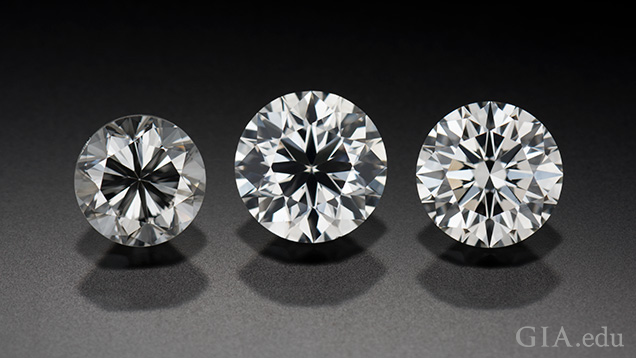GIA Researchers Evaluate ‘Light Performance’ and Diamond Cut
March 12, 2020

The phrase “light performance” gets a lot of loose use in the diamond trade. Terms such as brightness, brilliance, fire and scintillation are defined by various organizations with both clear and vague descriptions. The correlation of any of these properties to a diamond’s proportions are rather broad, while specific claims of better appearance are made for narrow ranges of proportions (particularly the “Ideal” cut for round brilliants).
Major deficiencies in a round brilliant’s appearance produced by extreme proportions have been understood for a century. Phenomena such as a fish-eye, dark center or dark mains that extend to the stone’s edge, produced, respectively, a too shallow pavilion, a too deep pavilion or a mismatch between crown height and pavilion depth. The discussion for more than 75 years has been focused on “proving” which proportions offer the best appearance.
But does “light performance” have an agreed-upon meaning? Just what does it mean?
In regard to diamond appearance, many would assume that high light performance means all observers will love the diamond. But how much of a part has human observation played in the development of any system for evaluating light performance in polished diamonds? In particular, do observers visually value the properties that are used in various approaches to exploring light performance?
How is light performance evaluated?
The most widely discussed method for evaluating light performance in recent decades uses a colored dome or cylindrical viewer, some with layers of colors. The colored dome or cylindrical viewer is used either as part of a device for viewing a diamond, or employed in a computer model with the 3D measurement (wireframe) of a diamond as input. This approach yields an image whose colored pattern reveals how the light that exits face-up and perpendicular to the table relates to the angles at which light enters the diamond. The pattern depends on both the proportions and symmetry of the diamond. It does not measure the amount of light exiting the diamond’s crown, and many implementations exclude specific evaluation of either fire or scintillation. There are various criteria for how much pattern difference is permitted within each grade range. Some users of this method include tilting the diamond, while others use only the face-up perpendicular position.
In all its variations, this approach assumes that the chosen standard addresses all issues regarding the balance of brightness, fire, contrast pattern and sparkle that are desirable in a diamond. None of the users of this approach have reported on human observations to verify that their conclusions make visual sense.
Another method uses an imaging spectrophotometer to obtain five images of the diamond at different distances from the light source. These images are analyzed for the amount of bright white light (described as brightness), colored light (described as fire) and differences among them (described as scintillation). This approach yields a measure of light exiting the diamond’s crown, but quantitative results are not presented. Instead, the three analyzed values are displayed on bar graphs relative to a database of thousands of previously measured diamonds of the same shape. The device does not permit tilting of the diamond relative to either the light source or detector. The question looms again, were any human observations conducted to verify that the three output values correlate to what people see?
Other factors that affect light performance
Some of the light performance information out there is very questionable. Polished diamonds return less than half the light energy that enters them, not “most” of it. Brighter does not indicate better appearance, because brightness is different than brilliance — both a mirror and a sheet of white paper return a lot of light, but neither is brilliant.
Human perception of brilliance requires a well-distributed contrast of light and dark areas. A diamond with good contrast and somewhat lower light return can look better than one with high light return and little contrast. Additionally, the diamond should also “perform” well while rocking and tilting (the dynamic aspect of light performance). The change in contrast and brightness is an important part of what the eye sees and should be part of an evaluation of light performance.
Personal taste is an important factor of perceived light performance. During our observation experiments, GIA found broad agreement on the displeasing aspects of diamond appearance, such as large areas of darkness, but noteworthy disagreement on what is most pleasing. Focusing on a particular diamond appearance, such as Hearts & Arrows, to the exclusion of all others leaves little room for personal preference. Of course, GIA feels that information provided to a third party needs to be thorough and not just focused on one aspect of a diamond.
Note that light performance in many other systems does not include the impact of other important factors that provide comprehensive information about a diamond. Weight ratio (e.g. thick girdles), durability (risk for chipping) and craftsmanship (which includes symmetry and polish quality) are also very important criteria that should not be ignored in evaluating cut.
Coming back to the original question: what does light performance really mean? Since diamonds are something we wear to show to others, the answer should be tied a diamond’s visual appeal. Physics may say that a certain diamond under specific conditions returns more light than another, or has more fire than another, but do you and I see these things? Light performance should mean that computer modeling, instrumentation or any other methods that claim to evaluate a certain diamond and assign a value or a grade should be linked to what we actually see.
GIA continues to avoid the use of the term “light performance” because of the ambiguity with which the trade uses it.
Illene Reinitz is a senior project manager in GIA research. Al Gilbertson is project manager of cut research at GIA in Carlsbad. Ronnie Guerts is a longtime GIA researcher who recently retired.
.jpg)


